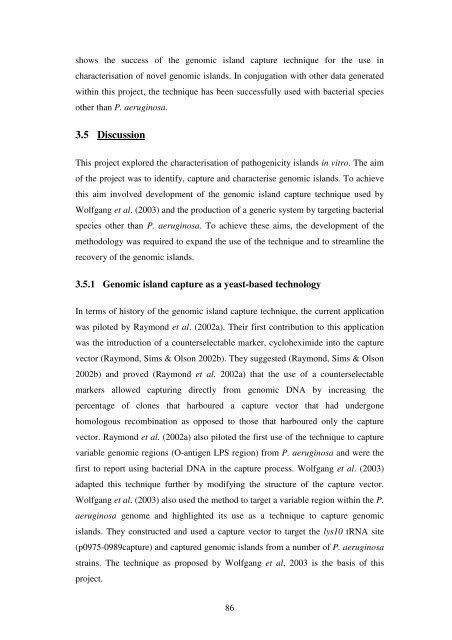5 The role of quorum-sensing in the virulence of Pseudomonas ...
5 The role of quorum-sensing in the virulence of Pseudomonas ...
5 The role of quorum-sensing in the virulence of Pseudomonas ...
You also want an ePaper? Increase the reach of your titles
YUMPU automatically turns print PDFs into web optimized ePapers that Google loves.
shows <strong>the</strong> success <strong>of</strong> <strong>the</strong> genomic island capture technique for <strong>the</strong> use <strong>in</strong><br />
characterisation <strong>of</strong> novel genomic islands. In conjugation with o<strong>the</strong>r data generated<br />
with<strong>in</strong> this project, <strong>the</strong> technique has been successfully used with bacterial species<br />
o<strong>the</strong>r than P. aerug<strong>in</strong>osa.<br />
3.5 Discussion<br />
This project explored <strong>the</strong> characterisation <strong>of</strong> pathogenicity islands <strong>in</strong> vitro. <strong>The</strong> aim<br />
<strong>of</strong> <strong>the</strong> project was to identify, capture and characterise genomic islands. To achieve<br />
this aim <strong>in</strong>volved development <strong>of</strong> <strong>the</strong> genomic island capture technique used by<br />
Wolfgang et al. (2003) and <strong>the</strong> production <strong>of</strong> a generic system by target<strong>in</strong>g bacterial<br />
species o<strong>the</strong>r than P. aerug<strong>in</strong>osa. To achieve <strong>the</strong>se aims, <strong>the</strong> development <strong>of</strong> <strong>the</strong><br />
methodology was required to expand <strong>the</strong> use <strong>of</strong> <strong>the</strong> technique and to streaml<strong>in</strong>e <strong>the</strong><br />
recovery <strong>of</strong> <strong>the</strong> genomic islands.<br />
3.5.1 Genomic island capture as a yeast-based technology<br />
In terms <strong>of</strong> history <strong>of</strong> <strong>the</strong> genomic island capture technique, <strong>the</strong> current application<br />
was piloted by Raymond et al. (2002a). <strong>The</strong>ir first contribution to this application<br />
was <strong>the</strong> <strong>in</strong>troduction <strong>of</strong> a counterselectable marker, cycloheximide <strong>in</strong>to <strong>the</strong> capture<br />
vector (Raymond, Sims & Olson 2002b). <strong>The</strong>y suggested (Raymond, Sims & Olson<br />
2002b) and proved (Raymond et al. 2002a) that <strong>the</strong> use <strong>of</strong> a counterselectable<br />
markers allowed captur<strong>in</strong>g directly from genomic DNA by <strong>in</strong>creas<strong>in</strong>g <strong>the</strong><br />
percentage <strong>of</strong> clones that harboured a capture vector that had undergone<br />
homologous recomb<strong>in</strong>ation as opposed to those that harboured only <strong>the</strong> capture<br />
vector. Raymond et al. (2002a) also piloted <strong>the</strong> first use <strong>of</strong> <strong>the</strong> technique to capture<br />
variable genomic regions (O-antigen LPS region) from P. aerug<strong>in</strong>osa and were <strong>the</strong><br />
first to report us<strong>in</strong>g bacterial DNA <strong>in</strong> <strong>the</strong> capture process. Wolfgang et al. (2003)<br />
adapted this technique fur<strong>the</strong>r by modify<strong>in</strong>g <strong>the</strong> structure <strong>of</strong> <strong>the</strong> capture vector.<br />
Wolfgang et al. (2003) also used <strong>the</strong> method to target a variable region with<strong>in</strong> <strong>the</strong> P.<br />
aerug<strong>in</strong>osa genome and highlighted its use as a technique to capture genomic<br />
islands. <strong>The</strong>y constructed and used a capture vector to target <strong>the</strong> lys10 tRNA site<br />
(p0975-0989capture) and captured genomic islands from a number <strong>of</strong> P. aerug<strong>in</strong>osa<br />
stra<strong>in</strong>s. <strong>The</strong> technique as proposed by Wolfgang et al, 2003 is <strong>the</strong> basis <strong>of</strong> this<br />
project.<br />
86














